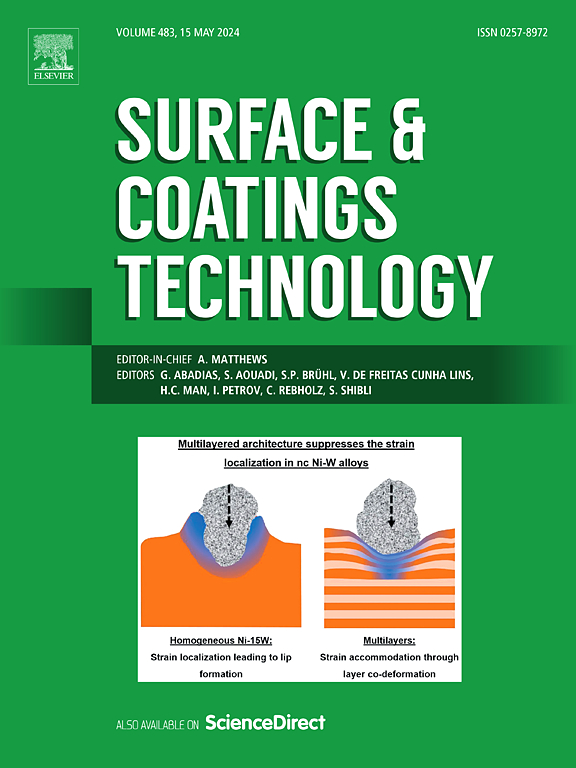Insights on the pulsed-DC powder-pack boriding process: equivalent circuit modeling and electric field distribution in the powder mixture–steel system
IF 5.3
2区 材料科学
Q1 MATERIALS SCIENCE, COATINGS & FILMS
引用次数: 0
Abstract
This study presents a novel equivalent circuit model that incorporates a network of resistances in both series and parallel configurations to describe the electrical resistance behavior of the powder mixture-AISI 1018 steel system during pulsed-DC powder-pack boriding (PDCPB). The system was divided into volumetric blocks to represent the electrical characteristics of different powder mixture regions containing square steel samples of varying surface areas. For a powder mixture composition of 70 % B4C, 20 % SiC, and 10 % KBF4, the electrical resistivity remained consistent across different steel dimensions and volumetric block sizes, yielding a value of 1.6 Ωm with an error margin of no more than 7 % compared to experimental data.
Furthermore, finite element simulations revealed that the magnitude of the electric field during PDCPB is critical for maintaining uniform FeB-Fe2B layer growth. Variations in steel dimensions influenced the final boride layer thickness, corresponding to current densities of 558 mA cm−2, 361 mA cm−2, and 263 mA cm−2, respectively. The highest current density facilitated a greater B+ concentration, enhancing boride layer formation. Finally, these findings provide valuable insights for predicting the electrical behavior of various powder mixture-material systems before PDCPB, facilitating process optimization for improved boride layer formation.
脉冲直流粉末包渗硼过程的见解:粉末混合钢系统的等效电路建模和电场分布
本研究提出了一种新的等效电路模型,该模型包含串联和并联配置的电阻网络,以描述脉冲直流粉末包渗(PDCPB)过程中粉末混合物- aisi 1018钢系统的电阻行为。该系统被分成体积块,以表示含有不同表面积的方钢样品的不同粉末混合物区域的电特性。对于由70% B4C、20% SiC和10% KBF4组成的粉末混合物,电阻率在不同钢尺寸和体积块尺寸上保持一致,与实验数据相比误差不超过7%,其值为1.6 Ωm。此外,有限元模拟结果表明,电场的大小对于保持FeB-Fe2B层的均匀生长至关重要。钢尺寸的变化影响最终的硼化物层厚度,对应的电流密度分别为558 mA cm - 2、361 mA cm - 2和263 mA cm - 2。较高的电流密度有利于更高的B+浓度,促进硼化物层的形成。最后,这些发现为预测PDCPB前各种粉末混合物材料体系的电学行为提供了有价值的见解,促进了工艺优化,以改善硼化物层的形成。
本文章由计算机程序翻译,如有差异,请以英文原文为准。
求助全文
约1分钟内获得全文
求助全文
来源期刊

Surface & Coatings Technology
工程技术-材料科学:膜
CiteScore
10.00
自引率
11.10%
发文量
921
审稿时长
19 days
期刊介绍:
Surface and Coatings Technology is an international archival journal publishing scientific papers on significant developments in surface and interface engineering to modify and improve the surface properties of materials for protection in demanding contact conditions or aggressive environments, or for enhanced functional performance. Contributions range from original scientific articles concerned with fundamental and applied aspects of research or direct applications of metallic, inorganic, organic and composite coatings, to invited reviews of current technology in specific areas. Papers submitted to this journal are expected to be in line with the following aspects in processes, and properties/performance:
A. Processes: Physical and chemical vapour deposition techniques, thermal and plasma spraying, surface modification by directed energy techniques such as ion, electron and laser beams, thermo-chemical treatment, wet chemical and electrochemical processes such as plating, sol-gel coating, anodization, plasma electrolytic oxidation, etc., but excluding painting.
B. Properties/performance: friction performance, wear resistance (e.g., abrasion, erosion, fretting, etc), corrosion and oxidation resistance, thermal protection, diffusion resistance, hydrophilicity/hydrophobicity, and properties relevant to smart materials behaviour and enhanced multifunctional performance for environmental, energy and medical applications, but excluding device aspects.
 求助内容:
求助内容: 应助结果提醒方式:
应助结果提醒方式:


